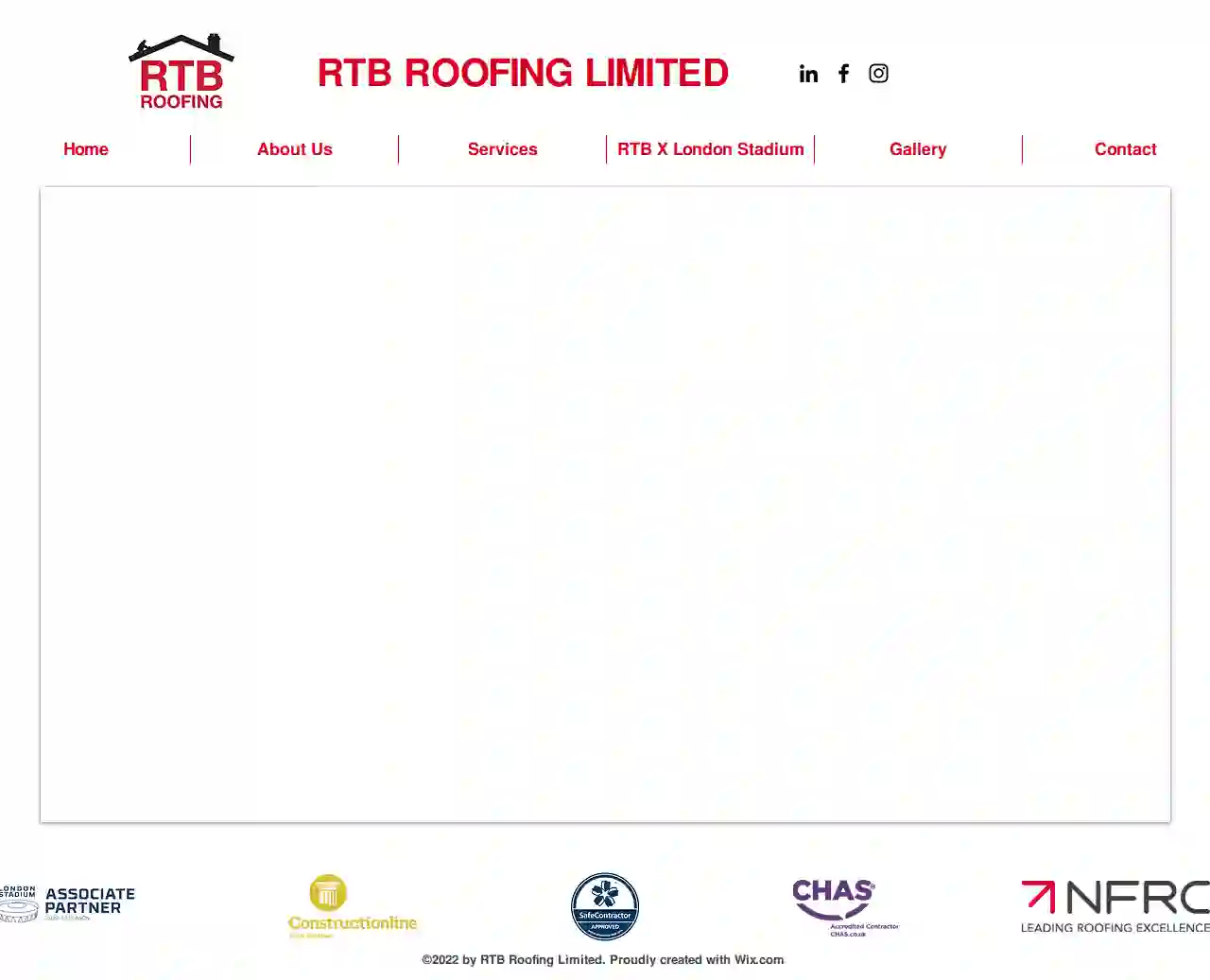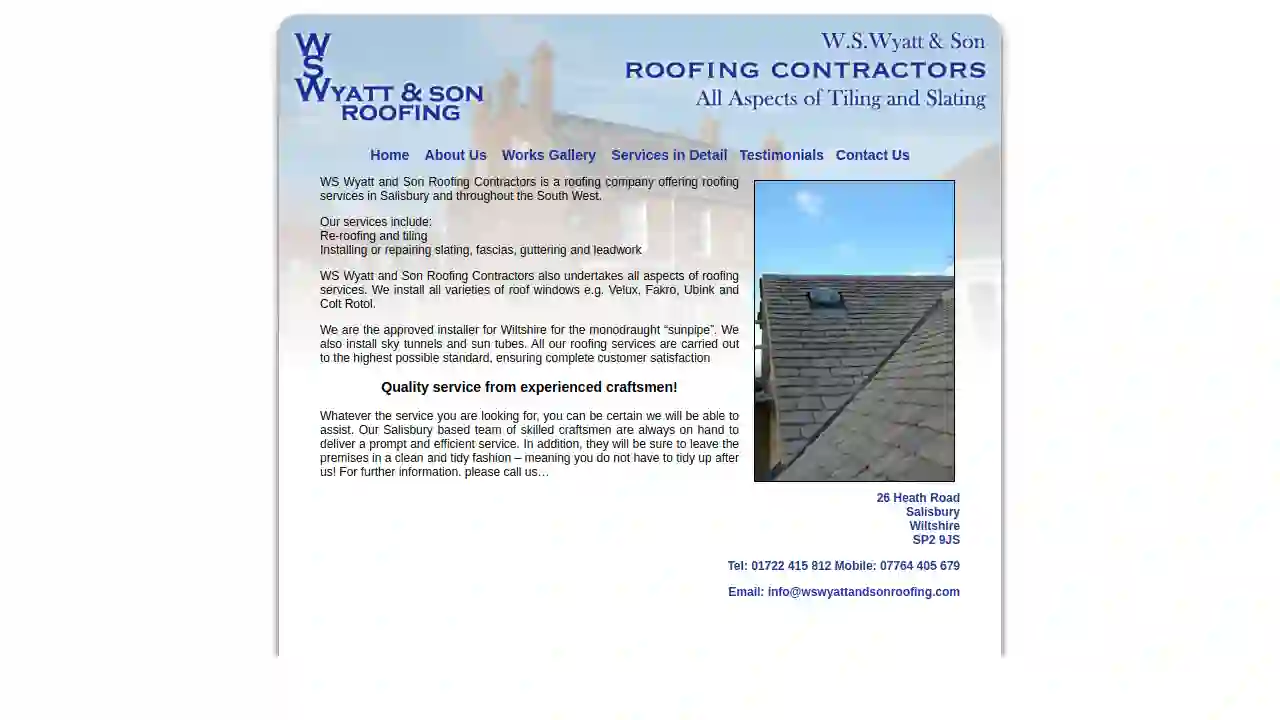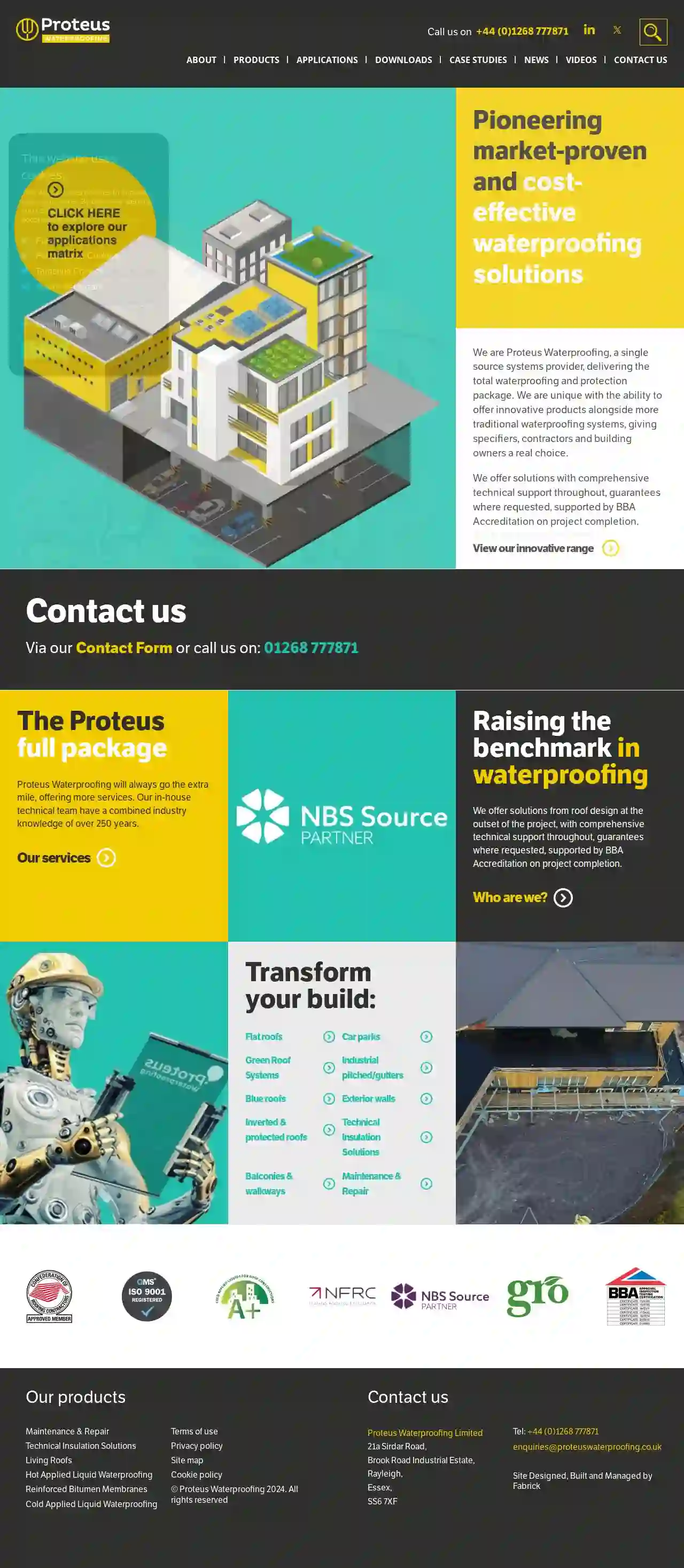Commercial Roofers Bolton
Top Commercial Roofer in Bolton
Receive 3 FREE Commercial Roofers quotes for your project today! Compare profiles, reviews, accreditations, portfolio, etc... and choose the best deal.

Four Seasons Roofing & Building Ltd
4.17 reviews4 Capricorn Centre, Cranes Farm Road, Basildon, SS14 3JJ, GBRoofing and Building Specialists. Welcome to Four Seasons Roofing Building Ltd At Four Seasons Roofing Building, we provide exceptional domestic and commercial (Industrial) roofing services in Brentwood, Essex, London, and throughout the M25 corridor. Our professional and certified roofers have expert knowledge and years of experience in all aspects of roofing services. From brand new installations to roof repairs and maintenance, we follow a set of very high standards and complete roofing projects on budget and on time.Although we can undertake any roofing requirements, we are considered the rubber roofing specialists throughout the roofing industry.
- Services
- Why Us?
- Gallery
Get Quote
One Stop Roofing Shrewsbury - Flat Roofing & Roof Repairs
Lower House Farm, Sidbury, Bridgnorth, WV16 6PY, GBAt One Stop Roofing, our specialization lies in flat roof installations, with a particular expertise in EPDM rubber roofs, rubber, and fiberglass. We take pride in offering a comprehensive range of services, including roof installation, repairs, and maintenance. Additionally, we have extensive knowledge and experience in handling fascia's, soffits, roof lanterns, skylights and guttering, ensuring that all your roofing needs are taken care of under one roof. We are a family business with over 35 years’ experience in the roofing trade, specializing in rubber and fibreglass roofing, as well as all types of roof and chimney repairs. Our team supplies and fits new build roofs, flat roofs, lantern and warm roofs - all using the best materials and construction to ensure you are dry and warm, no matter what the weather.
- Services
- Why Us?
- Accreditations
- Our Team
- Testimonials
- Gallery
Get Quote
The Fascia Division
59 reviewsLeigh, GBThe Fascia Division is a specialist installer of replacement fascias, soffits, guttering, and cladding. We offer a 10-year installation guarantee and are certified preferred installers for Hardie Plank cladding. Our team of experienced craftsmen provides high-quality installations, and we don't use reps or high-pressure selling techniques. We offer free no-obligation fixed quotations and our work is covered by a 10-year installation warranty with an optional IBG (Insurance Backed Guarantee).
- Services
- Why Us?
- Accreditations
- Our Team
- Testimonials
- Gallery
Get Quote
Universal Contracting Limited
4.58 reviews35 Chequers Court Brown Street, Salisbury, 35 Chequers Court Brown Street Salisbury, SP1 2AS, GBUniversal Contracting Ltd are industrial and commercial property developers based in Romsey, Hampshire. We are specialists in: ✓ Commercial Washrooms ✓ Commercial Maintenance ✓ Roofing Contractors ✓ Flooring Contractors We are commercial property contractors and experts in all aspects of industrial and commercial property refurbishment with a broad range of experience and expertise, covering all building works and construction sectors. We operate throughout Dorset, Surrey and other counties of Southern England and London.
- Services
- Why Us?
- Testimonials
- Gallery
Get Quote
LRH ROOFING SERVICES
521 reviewsGBAt LRH Roofing and Building Services, we’re passionate about good roofing standards, exceptional service and positive team spirit. We understand how valuable your time is, which is why we will leave no stone unturned in order to find the right solution for your roofing projects. I established LRH Roofing and Building Services, a company dedicated to finding cutting-edge solutions and providing great services. Our services aim to satisfy all of our customers, anytime, anywhere. We are committed to customer satisfaction as our top priority. If you want to learn more about how we do business, give us a call today. LRH Roofing and Building Services is committed to providing creative and scalable solutions for every customer. We know that each customer is different, which is why we try to customize each project to suit your needs. Learn more about what we offer below and give us a call to arrange a free survey. All of our services, especially this one, exist to make your life easier and stress-free. You can trust us to provide you with the best products, as well as the highest quality customer service. Get in touch to learn more. All our surveys are free of charge. We always aim to give you the best professional advice to suit your needs. Please get in touch so we can also give you a great price
- Services
- Why Us?
- Accreditations
- Gallery
Get Quote
RTB Roofing Limited
4.26 reviewsGBRTB Roofing Limited is a roofing company based in London, UK. We are a family-run business with over 20 years of experience in the roofing industry. We offer a wide range of roofing services, including new roof installations, roof repairs, and roof maintenance. We are fully insured and accredited by the National Federation of Roofing Contractors.
- Services
- Why Us?
- Accreditations
- Gallery
Get Quote
W S Wyatt & Son
3.73 reviews26 Heath Road, Salisbury, SP2 9JS, GBWS Wyatt and Son Roofing Contractors is a roofing company offering roofing services in Salisbury and throughout the South West. Our services include: Re-roofing and tiling, Installing or repairing slating, fascias, guttering and leadwork. WS Wyatt and Son Roofing Contractors also undertakes all aspects of roofing services. We install all varieties of roof windows e.g. Velux, Fakro, Ubink and Colt Rotol. We are the approved installer for Wiltshire for the monodraught “sunpipe”. We also install sky tunnels and sun tubes. All our roofing services are carried out to the highest possible standard, ensuring complete customer satisfaction. Quality service from experienced craftsmen! Whatever the service you are looking for, you can be certain we will be able to assist. Our Salisbury based team of skilled craftsmen are always on hand to deliver a prompt and efficient service. In addition, they will be sure to leave the premises in a clean and tidy fashion – meaning you do not have to tidy up after us!
- Services
- Why Us?
- Our Team
- Testimonials
- Gallery
Get Quote
Proteus Waterproofing
4.410 reviewsBrook Road Industrial Estate, 21a Sirdar Road, Rayleigh, SS6 7XF, GBWe are Proteus Waterproofing, a single source systems provider, delivering the total waterproofing and protection package. We are unique with the ability to offer innovative products alongside more traditional waterproofing systems, giving specifiers, contractors and building owners a real choice. We offer solutions with comprehensive technical support throughout, guarantees where requested, supported by BBA Accreditation on project completion. Proteus Waterproofing has an enviable reputation for delivering innovative products and systems for every type of design situation. Call us today and discover how our technical team can help with your next project. Check out advanced systems such as Proteus Cold Melt® which is proven to significantly reduce time on site, especially in new build situations with green concrete and much, much more… Proteus Waterproofing will always go the extra mile, offering more services. Our in-house technical team have a combined industry knowledge of over 250 years. We offer solutions from roof design at the outset of the project, with comprehensive technical support throughout, guarantees where requested, supported by BBA Accreditation on project completion. Experience the power of precision with Proteus Waterproofing, the UK's fastest-growing provider of waterproofing solutions, now available on the National Building Specification (NBS) platform. Raising the benchmark in waterproofing
- Services
- Why Us?
- Accreditations
- Gallery
Get Quote
AK Roofing Manchester
56 reviews54 Hulme Road, Leigh, WN7 5BT, GBAK Roofing is a premier roofing company serving Manchester and the surrounding areas. We are a family-run business with over 15 years of experience in the roofing industry. We pride ourselves on providing high-quality workmanship, competitive rates, and excellent customer service. Our team of skilled roofers is fully qualified and insured to handle all types of roofing projects, from small repairs to complete roof replacements. We offer a wide range of roofing services, including flat roof repairs, chimney repairs, gutter repairs, leadwork and guttering, fascia and soffit installation, drone roof surveys, Velux window installation, pest protection, and roofing finance. We are committed to providing our customers with the best possible roofing solutions to meet their needs and budget.
- Services
- Why Us?
- Accreditations
- Our Team
- Testimonials
- Gallery
Get Quote
Roofline Roofing & Cladding Ltd
4.821 reviews293 The Chase, Benfleet, SS7 3DN, GBRoofline is a family-run business with decades of experience installing and repairing domestic roofs. Based in Benfleet, Essex, they pride themselves on their local reputation and commitment to high-quality workmanship. As time-served tradesmen, they offer free, no-obligation quotes with no hidden costs. Roofline ensures projects are completed on time, within budget, with minimal disruption, and to the exacting standards they are known for. They specialize in leak detection and prevention, and their team is dedicated to providing a professional, friendly, and reliable service.
- Services
- Why Us?
- Accreditations
- Our Team
- Testimonials
- Gallery
Get Quote
Over 12,314+ Roofing Companies in our network
Our roofing pros operate in Bolton & surroundings!
Roofyng.co.uk has curated and vetted the Best Roofing Contractors in and around Bolton. Find a trustworthy contractor today.
Commercial Roofing FAQs
- Built-Up Roofing (BUR): A traditional, multi-layered system consisting of alternating layers of asphalt and reinforcing fabric. It's known for its durability, waterproofing capabilities, and affordability.
- Modified Bitumen Roofing: A single-ply system that uses asphalt-based sheets modified with polymers for enhanced flexibility, durability, and weather resistance. It's a versatile and cost-effective option for various commercial buildings.
- Single-Ply Membrane Roofing: A modern system using a single layer of waterproof membrane, typically made from EPDM (ethylene propylene diene monomer) rubber, TPO (thermoplastic polyolefin), or PVC (polyvinyl chloride). These membranes offer excellent waterproofing, energy efficiency, and ease of installation.
- Metal Roofing: Known for its longevity, durability, and fire resistance, metal roofing is a popular choice for commercial buildings. Available in various styles, including standing seam, corrugated, and metal shingles.
- Spray Polyurethane Foam (SPF) Roofing: A spray-applied roofing system that forms a seamless, monolithic membrane, providing exceptional insulation, waterproofing, and energy efficiency.
- Green Roofing: A system that involves covering the roof with vegetation, soil, and drainage layers. Offers environmental benefits, including reduced stormwater runoff, improved air quality, and energy efficiency.
- Manufacturer's Warranty: Offered by the manufacturer of the roofing materials and typically covers defects in the materials themselves, such as premature failure, curling, or discoloration. The length of the warranty can vary depending on the material and manufacturer, ranging from a few years to a lifetime.
- Contractor's Warranty: Provided by the roofing contractor and covers the quality of the installation workmanship. This warranty typically covers leaks or other issues that arise due to improper installation and is usually for a shorter period, often 1 to 10 years.
- Extended Warranties: Options to extend the standard warranty period for an additional cost.
- Specific Warranties: Covering specific aspects of the roofing system, such as ponding water resistance or wind uplift resistance.
- Drain Strainer: A grate or screen that prevents debris from clogging the drainpipe.
- Drain Body: Collects the water from the roof.
- Drainpipe: Connects to the building's drainage system, directing the water away.
How much does a commercial roof cost in the UK?
What are the different types of commercial roofing systems?
What are the different types of roof warranties?
What is a roof drain, and how does it work?
How much does a commercial roof cost in the UK?
What are the different types of commercial roofing systems?
- Built-Up Roofing (BUR): A traditional, multi-layered system consisting of alternating layers of asphalt and reinforcing fabric. It's known for its durability, waterproofing capabilities, and affordability.
- Modified Bitumen Roofing: A single-ply system that uses asphalt-based sheets modified with polymers for enhanced flexibility, durability, and weather resistance. It's a versatile and cost-effective option for various commercial buildings.
- Single-Ply Membrane Roofing: A modern system using a single layer of waterproof membrane, typically made from EPDM (ethylene propylene diene monomer) rubber, TPO (thermoplastic polyolefin), or PVC (polyvinyl chloride). These membranes offer excellent waterproofing, energy efficiency, and ease of installation.
- Metal Roofing: Known for its longevity, durability, and fire resistance, metal roofing is a popular choice for commercial buildings. Available in various styles, including standing seam, corrugated, and metal shingles.
- Spray Polyurethane Foam (SPF) Roofing: A spray-applied roofing system that forms a seamless, monolithic membrane, providing exceptional insulation, waterproofing, and energy efficiency.
- Green Roofing: A system that involves covering the roof with vegetation, soil, and drainage layers. Offers environmental benefits, including reduced stormwater runoff, improved air quality, and energy efficiency.
What are the different types of roof warranties?
- Manufacturer's Warranty: Offered by the manufacturer of the roofing materials and typically covers defects in the materials themselves, such as premature failure, curling, or discoloration. The length of the warranty can vary depending on the material and manufacturer, ranging from a few years to a lifetime.
- Contractor's Warranty: Provided by the roofing contractor and covers the quality of the installation workmanship. This warranty typically covers leaks or other issues that arise due to improper installation and is usually for a shorter period, often 1 to 10 years.
- Extended Warranties: Options to extend the standard warranty period for an additional cost.
- Specific Warranties: Covering specific aspects of the roofing system, such as ponding water resistance or wind uplift resistance.
What is a roof drain, and how does it work?
- Drain Strainer: A grate or screen that prevents debris from clogging the drainpipe.
- Drain Body: Collects the water from the roof.
- Drainpipe: Connects to the building's drainage system, directing the water away.